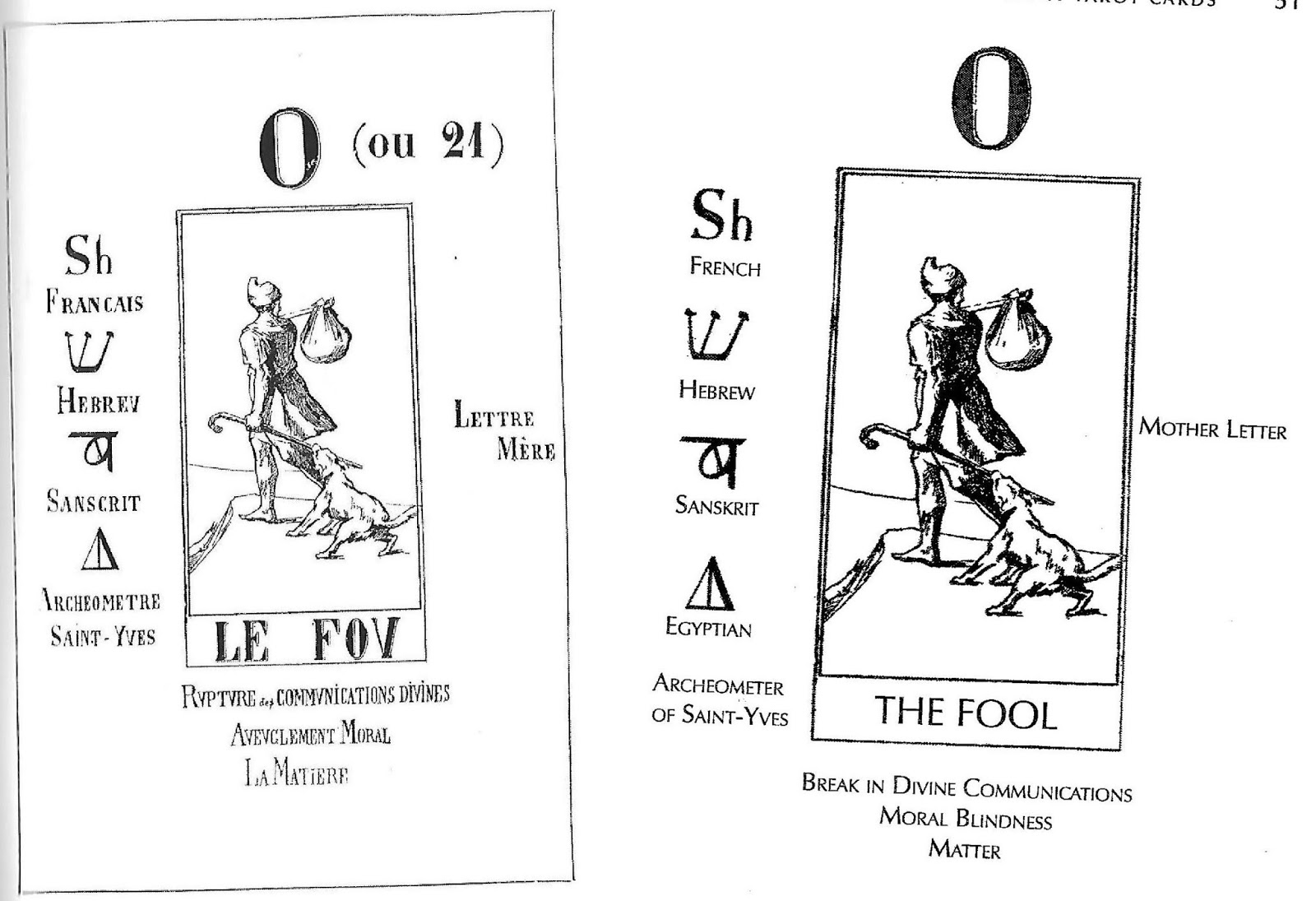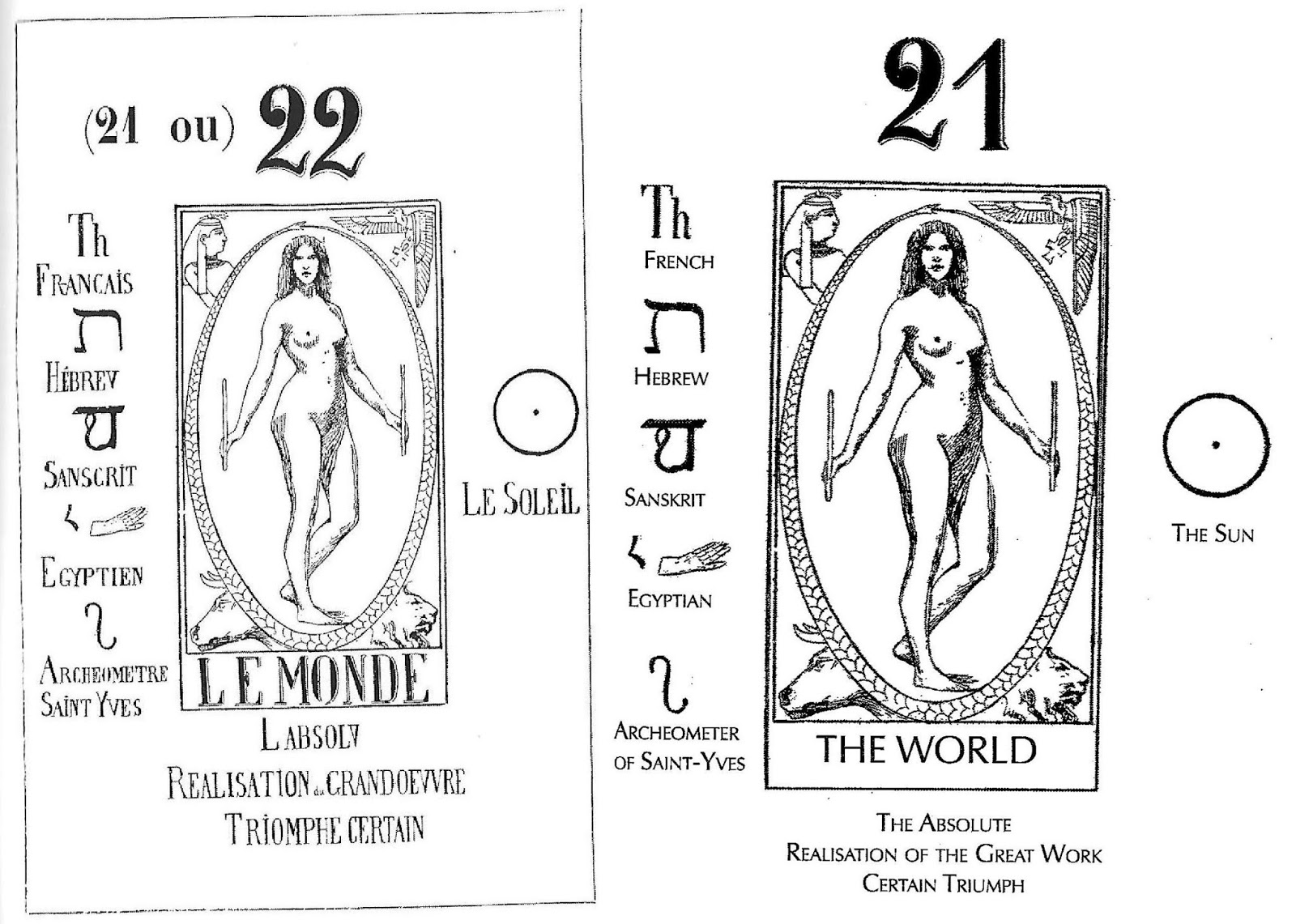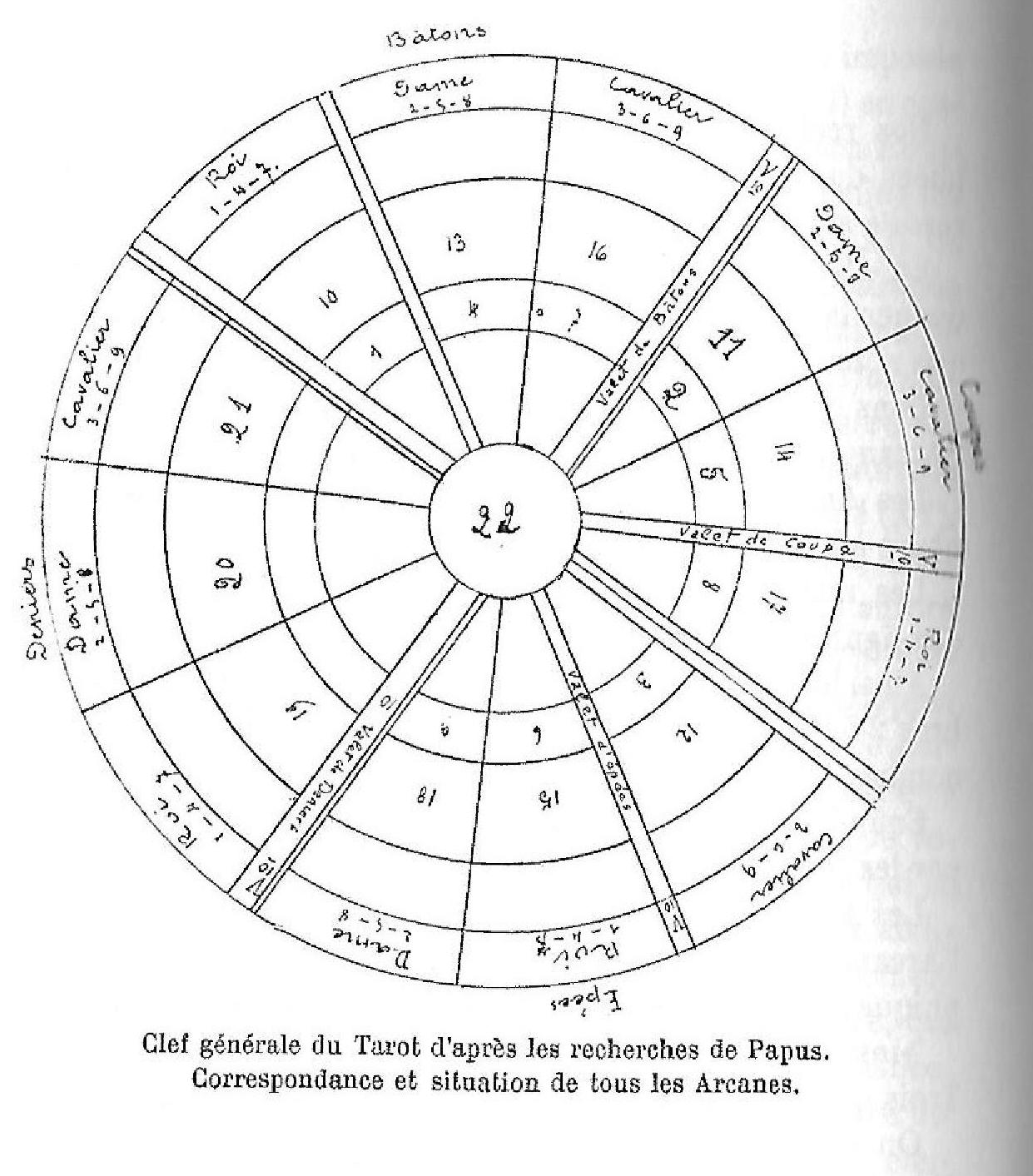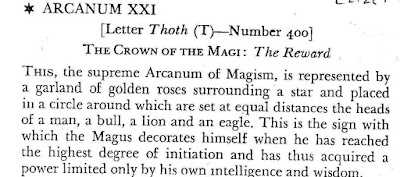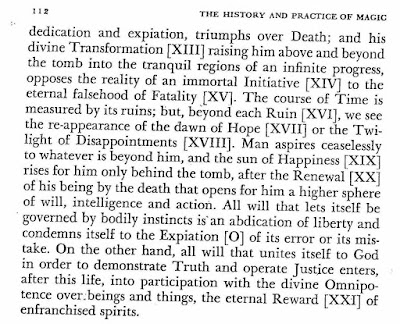Papus had designed an Egyptian-style deck and thought he could integrate the disparate work of Etteilla on the one hand and Levi and Christian on the other. The result (Levi made numerous disparaging remarks about Etteilla) is not without its problems, one of which is that the English translation omits some crucial comments in the book about and from Etteilla.
Having recently been sent scans of Papus's book in French, I want to try to rectify that situation, based on what Papus actually wrote.
The main part of Stockwell's English translation is the reproduction of Papus's cards along with, on the facing pages, his quotations from Christian and Etteilla (as filtered through his follower D'Odoucet) relating to that card. Stockwell explains that she had to do some rearranging of Papus's text to do this, as Etteilla's "synonyms" are in one place(Chapter 6 of the original), Christian in another place (the first part of his Chapter 7, pp. 167-186) and the cards after that (Chapter 7pp. 187 on). There is also the problem that Etteilla's correspondences to the Marseille deck do not match Papus's correspondences to Christian's, which follows the Marseille order precisely.
Part of the problem is that Etteilla's cards vary greatly from the standard Marseille deck and also, to a large extent, from Levi's and Christian's modifications of the Marseille. In most cases it is merely a matter of the order of the trumps. But Etteilla got rid of four Marseille trumps and substituted his own, and also "restored" the Hanged Man to its proper role as Prudence. How could the new ones be correlated with the Marseille?
Etteilla himself was quite clear, in his writings before producing his own deck, on how to transform a Marseille or Besancon deck into one suitable for his brand of cartomancy: you simply wrote his card numbers and meanings on them. He gave the correspondences in both his 3rd and 2nd Cahiers. In the 3rd Cahier he gave the Marseille title along with his own card number and "restored" meaning.
But second-hand reports of Etteilla's correspondences to the Marseille vary, not only between authors but in the same work. Compare Kaplan. Vol. 1, at the top of p. 140, where he gives the correlation of card 13, "Marriage", as "The High Priest", with the bottom of the page, where he gives the same card 13, Mariage, as corresponding to "L"Amoureux". In neither case does he cite a source.
Likewise, as "Tarot John" reminded me in an email, compare Decker, Depaulis and Dummett (Wicked Pack of Cards) on p. 86, based on "all four cahiers", but earlier just the 3rd Cahier, with what they say on p. 92.
On 86 we are told that Etteilla's card 1 corresponds to the Marseille Pope, 8 to the Popess, etc.

This goes on until Etteilla's card 21, corresponding to VII The Chariot, and then 0, for the Fool. I have uploaded the whole two pages at https://1.bp.blogspot.com/-JExbc8B8dDY/ ... ge-007.JPG. This list will prove to be correct.
Then on p. 92 we are told that Etteilla's card 1 corresponds to the Popess, while card 7 corresponds to the Pope, no references given except to "Etteilla's Tarot".

Here is the whole list: https://1.bp.blogspot.com/-A3-EEp9i3Dw/ ... ge-010.JPG
The correlations are different for cards 6 , 7, and 8, too. I am not aware of any work in which Etteilla changed his mind about these correspondences.
I think it is possible to remove th confusion by quoting Etteilla directly, in the 3rd Cahier. Or rather, I will quote from my translation, at http://thirdcahier.blogspot.com/. I am not aware of any publication in which Etteilla gave a different set of correspondences,
For Etteilla's card 1, we find the Marseille Pope mentioned, as the one to alter, by crossing out "Papa" and putting, apparently, "he who questions":
We find the second Marseille card, the Popess, mentioned in relation to Etteilla's card 8:No. 1. The Egyptians took this Card or sheet [Fr. lame = literally laminate in English], (*3) on which was drawn a Hieroglyph (4) for the man who consulted them; so this Sheet or Card means, or represents, he who questions the Oracles by the Book of Thoth.
______________
*3. They were of the finest gold, and their dimensions were 1 by 2.
*4. The Hieroglyph that was on this card is totally changed; thus without entering the matter, this Card offers today, according to the country where it is made, only a Jupiter, or a Pope, or a Swordsman.
We are also to alter the Empress and the Emperor cards, although it is not clear which of these words are to go on the cards:No. 8. This Card, or better this Hieroglyph, like both the preceding ones, no longer looks in any way like it was for the first Egyptians. (*7) Today on this Card we see a Juno, or a Female Pope, or a Spanish Girl; it means the woman for whom we question the Oracles of the Book of Thot.
____________
*7. The Dissertation that I made on this Card, proving in an irrefutable manner the sort of Hieroglyph it was originally, merited at Frankfurt-on-Main in 1777 the appellation of Astro-phil-astres, & Mage of France, in the terms of [aux termes de] the second [of the] human Sciences.
Here the keywords , when Etteilla put out his own deck, will be, for 6, Night and Day, and for 7, Support and Protection. Christian's interpretation, in terms of the Woman Clothed by the Sun, in which the Sun, Moon and Stars are all represented, correlates well with Night and Day, and support and protection work as a nice virtue for an Emperor to possess. Christian considered himself a favorite of Emperor Napoleon III, whose disastrous efforts to "protect" led to his removal from office the same way he got in, by military coup.No. 6. The Empress (*6) means, from something bad comes good, or, what has damaged us will become useful to us.
No. 7. The Emperor signifies support.
_________
*6. Our inestimable Ancients would certainly verify that this is mistaken: this Hieroglyph is modern; in one of the three other cahiers I will demonstrate that this was originally the fourth day of creation.
Finally, Marriage corresponds to Etteilla's card 13:
Of course there is no card called "Marriage" in the Marseille or Besancon tarot sequences. But the only one not assigned, and the logical one, is "L'Amoureux", the Lover. So we are to cross out "L'Amoureux" and put "Mariage".No. 13, Marriage (*9); this Hieroglyph is one of those on which the Egyptians were very expansive. They said: Marriage is the absolute will of the Creator, and whoever disturbs this agreement, or diverts its progress, will not live in this world, nor in the other. ...it means Marriage.
_____________
*9. In the work I give reasons for the transposition that I make of this Hieroglyph in the place of death, which I classify as No. 17. And without demonstrating here that I am just translating the thought of the Egyptians, I say that it is necessary to go back to the spirit of Marriage, which is birth, as birth is the spirit of death, and this one of life.
Also, for the Marseille I Bateleur he does give card 15, Illness. In fact, DDD do report all but four of the correspondences consistently right. And p. 92 does report correctly Etteilla's major advance from 1783 to 1789 about the cards, namely the keywords he thought up for the trumps, to replace his rather wordy expositions of 1783.. But Etteilla consistently had two keywords for each card. Sometimes it was the same word upright and reversed, but in some of the cases where DDD have given only one (e..g. the virtues), Etteilla in fact had two different ones.
Now that Etteilla's correspondences to the Marseille are straight, I will return to Stockman. For Papus's Hierophant, she puts Etteilla's synonyms for his card 13, Marriage, instead of those for his card 1, Etteilla/Questionant. Not only that, but Papus's card (now called "L'Amoureux") has two males bowing down to a male Hierophant, following Christian's description precisely. That's Marriage? Papus's image works well for Christian's text but fits Etteilla's only in a metaphorical way, i.e. the harmony and union between leader and follower.
https://1.bp.blogspot.com/-C8EBdxKZ48M/ ... e-005a.jpg (below)


My question for years has been: given that these last two correspondence are not Etteilla's, where do they come from? Are they Papus's, or are they the translator's? An editor's comment on all of them says, "Those given are supplied by Papus. Other attributions have been suggested." The "other attributions" are by those, I assume, who take their cue from Etteilla. But where does Papus "give" these attributions? Nowhere in the translation are they to be found.
Now that I have Papus's original, I can see the answer. He does give the correspondences, in sentences that appear with his quotations from d'Odoucet's "synonyms" but which the translator has left out. Here are the first two pages of Papus's original text: https://1.bp.blogspot.com/-dWMJKVLD_o4/ ... ge-001.JPG
For Card 1 he has "(Cette carte est special au Tarot d'Etteilla.)", i.e. "(This card is specific to the Tarot of Etteilla. )"
For card 2 he has "Correspond a la lame 19 du Tarot Egyptien reconstitui par nous" i.e. "Corresponds to card 19 of the Egyptian Tarot reconstituted by us."
For card 3 he has "Correspond a notre lame 18", i.e. "Corresponds to our card 18": https://1.bp.blogspot.com/-i2eyHoWsfH0/ ... ge-002.JPG
For the rest of the word-lists the wording in parentheses is the same as for Etteilla's card 3.
The point is that the synonym lists for Etteilla's cards are not meant, for Papus, to correspond to the Marseille cards, but to Papus's own cards, which correspond to Christian's descriptions. So it is no wonder that Papus's correspondences differ in a few places from Etteilla's: they are Etteilla correspondences brought to bear on Papus's cards, not the Marseille's. Even if the titles of Papus's cards are for ths most part the same as those of the Marseille, and the pictures mostly just the Marseille in Egyptian costume, the meanings are those of Christian plus the word-lists from Etteilla as Papus assigns them.
Thus the synonyms for Etteilla's card 13 apply to "our card" 5 -- i.e. Papus's, "Hierophant", not the Marseille's "Papa".. And the synonyms for Etteilla's card 1 apply to "our card" 6, i.e. Papus's Lover, and not the Marseille's, even if the main difference between the pictures is the costumes. Papus's deck comes with the interpretation and word-list of his choosing. The Marseille, in contrast, had a life very much independent from the LWB's written about it.
Stockman made other omissions of possible interest to people who may wish to learn from Papus. What I have found of significance are three charts, a long quotation in Spanish, and a second number on two of Papus's cards., omitted by Stockman I will get to these omissions later.

